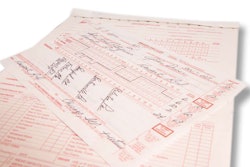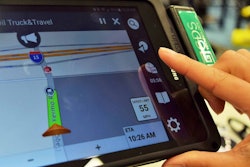 LaTonya Mimms, a specialist in FMCSA’s enforcement division, presented Thursday at the Great American Trucking Show alongside Danielle Smith, a specialist in FMCSA’s passenger carrier division.
LaTonya Mimms, a specialist in FMCSA’s enforcement division, presented Thursday at the Great American Trucking Show alongside Danielle Smith, a specialist in FMCSA’s passenger carrier division.Independent owner-operators will likely need to configure two types of electronic logging device accounts for the ELD mandate that takes effect Dec. 18, said a federal official.
Federal Motor Carrier Safety Administration representatives addressed drivers’ concerns about the mandate Thursday at the Great American Trucking Show in Dallas.
Independents will need a driver account and a support personnel account, given the nature of their roles as drivers and in administration of their business, said Danielle Smith, a transportation specialist in FMCSA’s passenger carrier division. “One account is not going to let you do both operations,” she said.
ELD accounts are established through drivers’ and carriers’ devices. Driver accounts are established with a driver’s name, CDL number and unique user name.
Driver accounts record drivers’ hours, whereas support accounts do not. Support accounts are meant for carrier personnel to perform administrative tasks like verifying logs, performing yard moves and downloading ELD data, among other uses.
ELD accounts are not allowed to be used by more than one person, Smith said, but users are allowed to have multiple accounts, as in the case of owner-operators needing both a driver account and a support account.

Upon adopting an ELD, drivers must have in their truck a user manual for their device, data transfer instructions, ELD malfunction instructions from the manufacturer, a supply of blank paper log books and paper supporting documents, said LaTonya Mimms, a transportation specialist in FMCSA’s enforcement division.
Such supporting documents include bills of lading, receipts for food and meals, dispatch records and other documents that aid in verifying hours of service compliance. Carriers must retain up to eight supporting documents for every 24 hours a driver is on duty. Drivers must file their logs and supporting documents with their carrier within 13 days.
 The two FMCSA officials presented before a packed crowd Thursday at the Great American Trucking Show.
The two FMCSA officials presented before a packed crowd Thursday at the Great American Trucking Show.All log records and supporting documents must be retained for six months, as is the law currently for paper logs and supporting documents.
Limited editing of electronic logs can be made by carriers or drivers, but drivers “ultimately have the right to accept or decline edits” made by carriers, says Mimms. If edits are made by either party, they must be annotated on the device, Smith says, to document the reason for the edit. In such cases, both the original logs and the edited logs must be retained.
“Edits are very limited,” says Mimms. “There are only certain things you can edit. Driving time cannot be shortened,” she said, except in the case of team drivers, who likely will share an ELD. In cases in which team drivers alternate shifts but forget to switch accounts, driving time case be re-assigned to the correct driver.
In the case of so-called unidentified driving, when a truck is in operation but no one is logged in to its ELD, the devices will record the drive time, which must later be assigned to an ELD account to stay compliant. Carriers can assign such driving time to a driver, but drivers can accept or decline such assigned time.
If they accept it, “that driving time can contribute to hours of service violations,” says Smith, if drivers were operating outside legal limits. Unidentified driving time can also be assigned to support personnel, such in the case of yard moves or local moves to a repair facility.
After the ELD mandate’s compliance date, drivers can still use their trucks for personal use. To do so, drivers must select personal conveyance mode on their device. “It’s not going to count against driving time, but it will still be reflected in the ELD,” Mimms said. “It will show up as a shaded, dotted or dashed area, and it will be embedded in a drivers’ off-duty time.”
Nearly all truckers required to keep paper logs must switch to an ELD by Dec. 18. Operators using an automatic onboard recording device (an ELD with more limited functionality and recording capabilities) by the Dec. 18 compliance date will have an extra two years to comply in full with the mandate.
Mimms recommended drivers begin using electronic logs as soon as they can to “get comfortable with the device,” she says. She also referred drivers to the agency’s website for resources on ELD compliance and choosing a device, available at this link.









